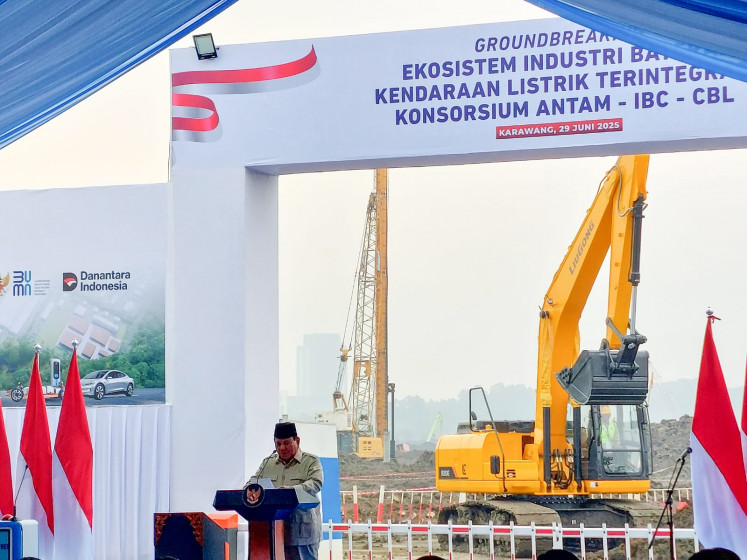Popular Reads
Top Results
Can't find what you're looking for?
View all search resultsPopular Reads
Top Results
Can't find what you're looking for?
View all search resultsStopping climate change is more affordable than you think
Fears about the costs of stopping climate change are one of the main obstacles to reaching an agreement in Paris
Change text size
Gift Premium Articles
to Anyone

F
ears about the costs of stopping climate change are one of the main obstacles to reaching an agreement in Paris. These costs, however, are actually quite modest when compared to the size of the global economy and wealth ' and they should be easily affordable.
An estimated US$3 trillion a year is needed for climate-related activities and broadly promoting sustainable development. This amount may seem hefty and unaffordable, even for richer countries. Global climate change negotiations have also focused on a much smaller $100 billion climate fund to help developing countries.
In comparison, world GDP in 2014 was over $78 trillion (more than $107 trillion at purchasing power parity), while total global financial assets reached $273 trillion. World savings that year totaled $17 trillion, with 46 percent from developing countries.
Thus, full funding for climate change and broad sustainable development activities ' including investment in education and health as well as renewable energy and climate-resilient infrastructure ' would be around 3 percent of global GDP per year. This includes the annual $100 billion by 2020 in climate finance pledged to poorer nations by developed countries in Copenhagen in 2009, which is only about 0.13 percent of global GDP and 0.037 percent of global wealth.
While the $100 billion pledged is not a large amount in the context of the global economy and wealth, the outcome of the Paris climate talks will hinge on whether wealthy countries deliver it.
The total costs of climate change mitigation in developing countries may run as high as $680 billion annually, plus an additional $100 billion per year to help them adapt to the impacts of climate change. $100 billion per year is clearly not enough.
Many climate-related costs can be covered by simply reallocating already planned investments, for example, away from fossil fuels to renewable energy, and from new roads to public transportation. This reallocation has already begun as renewable energy accounted for over half of new investment in electric power generation in 2014. Governments should also shift global fossil fuel subsidies, which were $550 billion in 2013, to support renewable energy and energy efficiency.
Large investments in energy, transportation, and other infrastructure are already being planned. Current investments in energy total more than $1.6 trillion per year. However, about $53 trillion of investments in renewable energy and energy efficiency will be needed by 2035 to address climate change, according to the International Energy Agency.
Stronger government policies could easily accelerate this trend, supplemented by voluntary actions by businesses and consumers.
Indeed, spending on climate change and sustainable development should be viewed as an investment, not just a cost. The real costs and, importantly, benefits, become clearer when climate change is considered holistically with sustainable development. Taking action on climate change, one of the 17 UN-led global goals for sustainable development, is a prerequisite for achieving all of the goals.
Energy efficiency and renewable energy are key focuses of investments needed to address climate change. Energy efficiency cuts costs and generates profits, and renewable energy enhances energy security and next-generation innovative technologies, while creating new jobs and industries. Investments in climate-resilient infrastructure, such as public transport and stronger building standards, will be the foundation of our future daily lives.
The inevitable costs of damage from climate change also need to be included in discussions of the costs of taking preventive action. Already climate change is impacting almost all aspects the economy across the globe. Global disaster-related losses, including those caused by extreme weather events, were $3.8 trillion between 1980 and 2012, according to the World Bank.
The entire $3 trillion could be generated by taxing global wealth by less than 1 percent per year.
Many of the world's largest cities are also threatened by rising sea levels, risking much of the world's wealth and productive capacity. Bank of England Governor Mark Carney recently warned about risks to insurance companies and financial stability.
In the Paris climate talks, the relatively modest annual $100 billion in climate finance for developing countries should be a side issue, not the main issue.
Developed countries, as well as many emerging economies, can afford it, and least developed countries need their assistance. Some emerging economies also can now fund many of their own actions, including shifting already planned investments, especially those that provide direct economic benefits, such as energy cost savings, energy security from renewable energy, and new climate-resilient infrastructure, which provides jobs and everyday living.
So in this context, $3 trillion per year of investment for sustainable development, including climate change, is neither unrealistic nor impractical, considering world GDP, savings, and wealth.
Direct new government budget outlays are not necessarily required to shift investments, which are mostly decided by private companies, in more sustainable directions. Instead, more robust regulations by governments are needed, supplemented by voluntary measures or partnerships.
Some government funding is necessary for some measures, especially fiscal policies that shift taxes from 'goods' like labor to 'bads' like pollution. Globally, taxes are already 28 percent of world GDP, approximately $23 trillion, so redirecting some towards sustainable, green investments is clearly feasible. Thus, an additional $1 trillion could be generated by a modest 5 percent increase in taxes globally. Alternatively, the entire $3 trillion in spending for sustainable development could be generated by taxing global wealth by less than 1 percent per year. Of course, some could be borrowed.
Other comparisons are possible. Oil giants Exxon and Chevron are among the 10 most profitable companies in the world, with combined revenues of over $560 billion and earnings of $52.9 billion in the second quarter of 2015. Global spending on advertising in 2015 was predicted to be $540 billion. Global military spending was $1.8 trillion in 2014.
Clearly, the world is not lacking money, but rather political motivation and understanding to mobilize it.
___________________
The writer is a principal researcher at the Institute for Global Environmental Strategies based in Hayama, Japan









